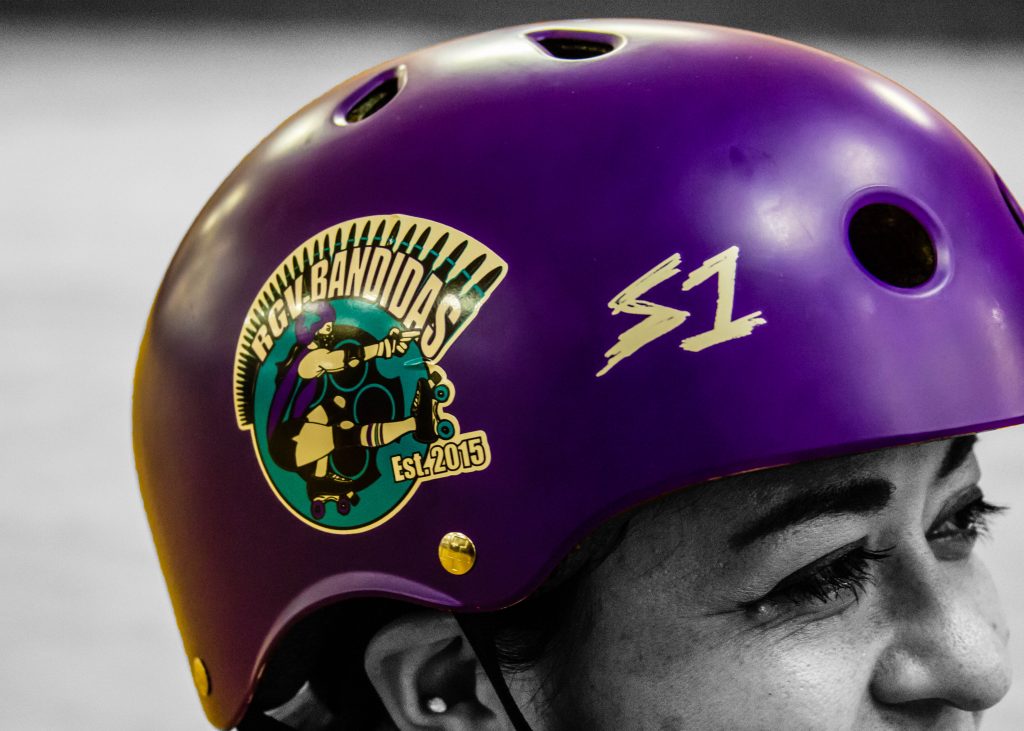On a Roller Derby: Local Team Prepares for Season Opener

By Erik L. Webster
@erik__the__red
HARLINGEN – Our entire lives we’re taught to settle for mediocrity. That just isn’t acceptable in roller derby.
That’s the point Crystal Hernandez, a UTRGV Junior and Communication Sciences and Disorders major made clear after a cold, late-night practice Thursday, Feb. 8.
“I feel like our entire life, we’re taught to settle for mediocrity,” Hernandez said. “I want to do it all. I want to succeed in this. And I’m gonna push past what I think I can do!”
The RGV Bandidas, a Women’s Flat Track Roller Derby club based out of Harlingen, are hard at work preparing to take on Monterrey Roller Derby Saturday, Feb. 17, at the Hot Skating Roller Rink in Harlingen, Texas.
According to the Women’s Flat Track Derby Association, or WFTDA, the term roller derby dates back to the 1920s and was originally used to describe marathon roller races. By the late ‘30s however, Leo Seltzer’s roller derby exhibition known as the Transcontinental Roller Derby, began to transform roller derby from a marathon skating race to a physical competition emphasizing collisions between skaters and falls. This transformation would serve as the basis of the team sport that exists today.
Interest in the sport increased rapidly during the 1940s when derby events began to be televised and by the time the ‘60s rolled around, competing roller derby franchises began to emerge across the nation. The success of roller derby in the ‘60s and ‘70s was relatively short-lived however, and in 1973, Jerry Seltzer, son of Transcontinental Roller Derby founder Leo Seltzer, shut down his roller derby organization.
Several roller derby revivals were attempted during the ‘80s and ‘90s. Many of which engaged in staged action and storylines, such as the RollerGames, which featured a figure-8 banked track and stunts like alligator pits. But it wasn’t until the early 2000s that modern women’s roller derby got its start.
In 2003, the Texas Rollergirls, based out of Austin, Texas, formed what would become the first league of the WFTDA. Shortly after, new leagues formed as businesses run by the athletes themselves. And because flat track roller derby can be played just about anywhere, given it doesn’t require a large banked track like traditional roller derby, the team sport has spread like wildfire, with 420 full member and 37 apprentice leagues spread across 29 countries.
The objective of flat track roller derby is simple. Score more points than the other team. Scoring those points is anything but though. According to the WFTDA Rulebook, play is broken into two 30-minute periods. Within those periods, gameplay is further divided into units of play called “Jams,” which last up to two minutes.
During a Jam, each team fields up to five skaters. Four of these skaters, known as “Blockers,” collectively form the “Pack.” The other player is called the “Jammer,” easily identified by a star on their helmet.
The opposing Jammers start each Jam behind the Pack, and score a point for every opponent they lap, each lap. Because they start behind the Pack, the Jammer must get through the Pack, then all the way around the track so that they can begin to score points for passing Blockers.
“The goal is to have your jammer score as many points as you can,” said RGV Bandidas Jammer and derby trainer Crystal Hernandez. “The team that has the most points at the end of the game is an obvious win. You have got defense and offense happening from the blockers, so your jammers are trying to get through while so much is going on at the same time,” Hernandez added.
“On the whistle, the jammer’s objective is to get through and, on the overlap, every person they pass from the other team is one point. The first lap doesn’t count. It’s the initial pass and everything after that counts,” she continued.
“You want to get lead,” she said, referring to the first Jammer to get past the Pack. “Lead gets to call off the jam. You want to get your jammer out first in order to basically sway the way the game is gonna go. It’s to your advantage to get lead,” Hernandez concluded.
According to their website, the RGV Bandidas resulted after the merging of two traditionally rival leagues, the South Texas Rolleristas, established in 2006, and the Mactown Rebel Rollers, established in 2012, and were the only two Women’s Flat Track Roller Derby teams to have ever been founded in the Rio Grande Valley.
The RGV Bandidas are a 501(c)(3) non-profit organization and welcome volunteers and anyone interested in playing to attend one of their three weekly practices.
The Bandidas’ next bout is scheduled for Saturday, Feb. 17, at 7 p.m. against Monterrey Roller Derby. Anyone interested in more information can reach the organization at www.rgvbandidas.com.






